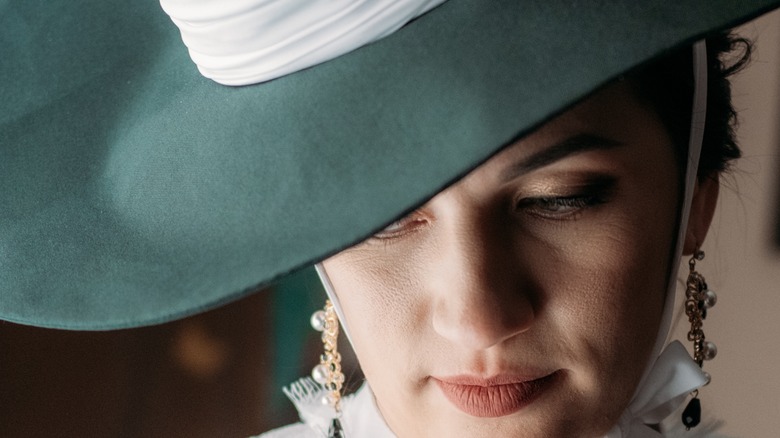The Death Of John Sheedy: A Story Of Adultery, Murder, And Morphine
Today, Lincoln, Nebraska's capital, is a small and scenic college known mostly for University of Nebraska-Lincoln Cornhusker football, much more so than anything like an illegal casino or murder. In 1891, the scene in Lincoln was much different, though, at least as far as one prominent Lincoln resident — real estate developer and illegal gambling impresario John Sheedy — was concerned. The proprietor of an underground gambling establishment in Lincoln and in an unhappy marriage, Sheedy was attacked on the streets of the town and survived. Nevertheless, the next day, Sheedy died from a suspected poisoning, Gilded Age Plains City writes.
Sheedy's wife, Mary Sheedy, and her lover, Monday McFarland, a Black man living in Lincoln at the time, were both accused of Sheedy's murder. McFarland confessed to striking Sheedy in the head with a cane at Mary's request, though the attack failed to kill him. For this reason, the prosecution alleged Mary tried to finish the job by poisoning her husband with morphine. Their motive: a piece of Sheedy's sizable estate. Through the John Sheedy murder trial, a lurid tale of adultery, morphine, and murder emerged in the small midwestern town. What really happened to Sheedy — as well as the role that McFarland and Mary played in the crime — remains uncertain to this day.
When she moved to Lincoln, Mary Sheedy was married to another man
John Sheedy moved to Lincoln, Nebraska in 1869 and quickly set about making a name for himself in the town selling liquor, hosting gambling, and dealing in prostitution. Still, despite repeated arrests and frequent fines, Sheedy continued to make his money in the seamy underside of Lincoln culture. Mary Merrill arrived in Lincoln a decade after John, in 1879. At that time, she was married to a man named George Merrill. Their marriage was troubled. Before long, George left Lincoln, and a short while after that, the pair divorced.
By 1885, Mary and John Sheedy traveled to New Orleans together, at which time she demanded Sheedy marry her. The couple were married before they returned to Nebraska. In 1890, Gilded Age Plains City says Sheedy and his wife Mary traveled to Buffalo, New York, where she was treated for a "disease peculiar to women." It's difficult to know what that meant, but women at that time were frequently diagnosed with hysteria, a pseudoscientific condition encompassing a number of health and mental health issues, Medical News Today explains.
Nonetheless, Sheedy returned to Lincoln without Mary. Still in New York, Mary took up with another man, Andrew (Harry) Walstrom. She eventually returned to Lincoln, and Walstrom followed.
Mary Sheedy had an affair with Monday McFarland
By 1890, Mary Sheedy had also engaged in an affair with barber Monday McFarland, a barber initially hired by John Sheedy to fix Mary's hair. She reportedly confessed to McFarland that her marriage to Sheedy was unhappy and that she was already having an affair with Andrew (Harry) Walstrom. Around this same time, McFarland said Mary offered him $20,000 to kill her husband, as The New York Times reported in 1891. After some convincing, McFarland agreed. After the murder trial, it was revealed the Sheedy estate was worth around $55,000, or roughly $1.8 million in 2023, made up mostly of real estate holdings (via Gilded Age Plains City).
The grisly task of killing Sheedy proved a challenge: McFarland reportedly tried to shoot Sheedy twice but failed, according to McFarland's confession (which he later retracted). Finally, McFarland is thought to have attacked Sheedy in the head with a cane, but Sheedy survived. After that attack, the gambling magnate — who was armed and fired back — returned home and sought medical attention for the wounds, not thought to be serious at the time. Attended to by his wife Mary, Sheedy's doctors gave him painkillers, and he went to sleep.
By 4 a.m. the next morning, Sheedy was unconscious. By 10 p.m. the next night, he was dead. Sheedy's doctors thought the probable cause was a brain hemorrhage caused by blows to the head.
No one was convicted
A short time after John Sheedy died, the love triangle of Monday McFarland, Andrew (Harry) Walstrom, and Mary Sheedy were all arrested for the Sheedy's murder. Both McFarland and Walstrom pleaded not guilty, as McFarland said his confession was made under duress. Walstrom was released for lack of evidence. By spring 1891, the trial of Mary and McFarland began. Mary stood accused of killing her husband with morphine, though no trace of morphine was found in his system. Sheedy's remains were exhumed, and still, no trace of poison was detected.
In the course of the trial, there was some suggestion from Mary and McFarland's defense that Sheedy's brother, Dennis Sheedy, may have framed them to get his hands on Sheedy's estate. Or could Sheedy's long history of what amounted to organized crime have caught up with him? The judge agreed that McFarland, a Black man, gave his confession under duress and was therefore inadmissible.
By late May 1891, a jury ruled Mary and McFarland not guilty on all counts, the Lincoln Journal Star reports. No one was ever convicted. From 1890 through around 1930, the seemingly idyllic small town of Lincoln had more unsolved and unusual murders per capita — such as the Sheedy case — than nearby Omaha, according to History Nebraska.



